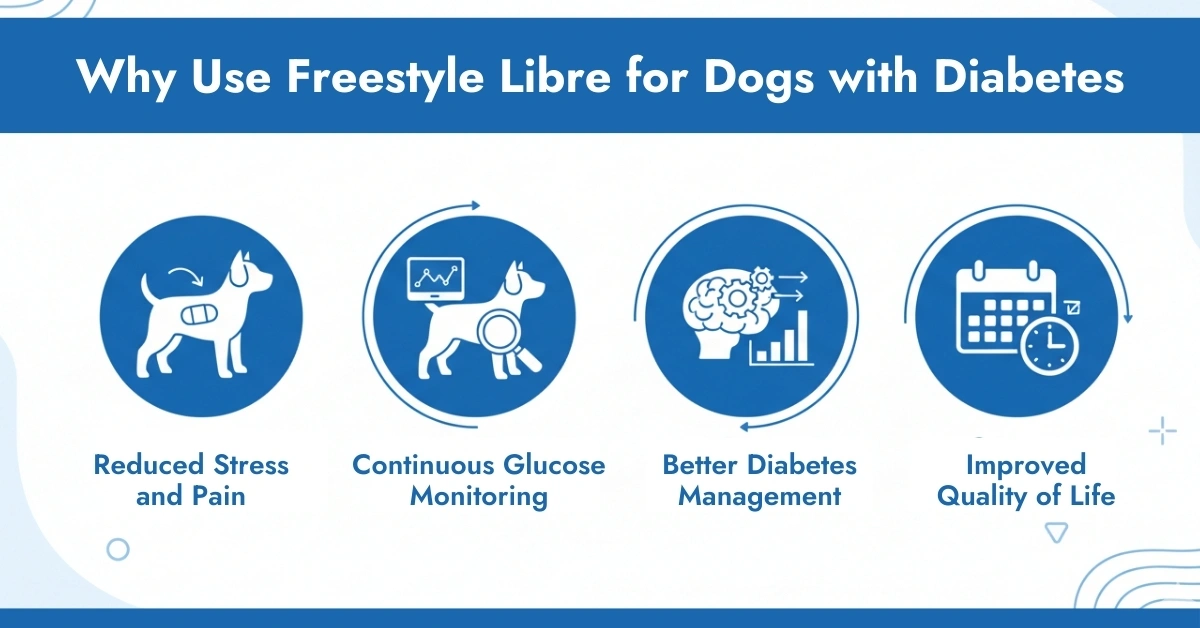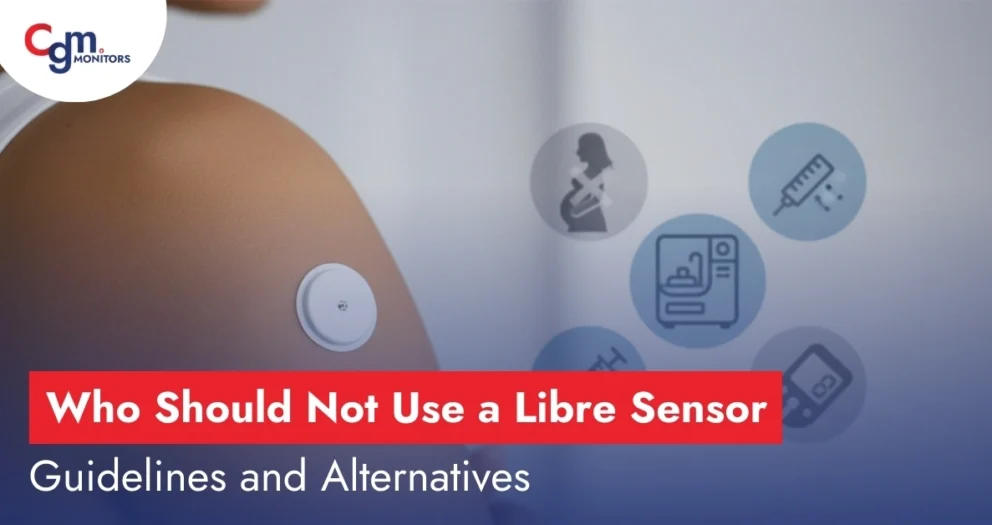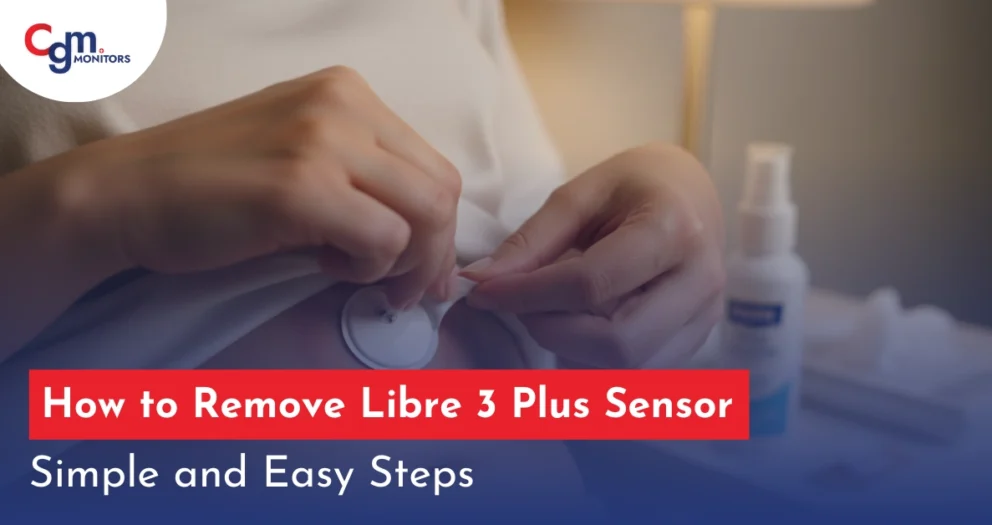Table of content
- FDA Blessing and Veterinary Use
- What Is Freestyle Libre for Dogs?
- Why Use Freestyle Libre for Dogs with Diabetes?
- How Does Freestyle Libre Work for Dogs?
- Is Freestyle Libre Safe for Dogs?
- How to Apply Freestyle Libre Sensor on a Dog
- Preventives for Using Libre Sensors in Dogs
- Pros and Cons of Freestyle Libre for Dogs
- Lifestyle Tips to Help Manage Blood Sugar in Domestic Animal
- User Feedback
- Conclusion
- Frequently Asked Question
Managing diabetes in dogs can be gruelling, but advancements in technology, such as the FreeStyle Libre for dogs, offer promising results. Keeping in view that these devices have been really helpful in managing diabetes in humans, most individuals have positive opinions about their use in pets as well. Let’s examine how this may work, identify the necessary precautions, and supplement it with some user feedback.
FDA Blessing and Veterinary Use
The FreeStyle Libre 2 is approved by the FDA for medical use, specifically for individuals aged 4 and aged. It’s classified as a Class II medical device. It’s still not officially approved for veterinary use in dogs. Despite this, veterinary professionals have espoused its use off-label due to its effectiveness in covering interstitial glucose situations in diabetic dogs.
What Is Freestyle Libre for Dogs?
Freestyle Libre for dogs refers to the off-label use of the Freestyle Libre Continuous Glucose Monitoring (CGM) system, originally designed for humans, to monitor glucose levels in diabetic dogs.
Instead of repeated blood samples from the ear or paw, the Freestyle Libre uses a small sensor applied to the dog’s skin that measures glucose levels in the interstitial fluid. The sensor continuously records data, which can be scanned using a compatible reader or smartphone app.
Important note: Freestyle Libre is not FDA-approved specifically for veterinary use, but many veterinarians recommend it due to its proven accuracy and convenience.
Did you know? Freestyle Libre 2 Plus Sensors, the latest ones among CGM sensors from Abbott, not only save you from finger pricks but are also compatible with automatic insulin delivery (AID) systems, such as Omnipod 5. And the best part, CGM Monitors offers flexible payment options, allowing you to buy using your debit/credit card or claim using insurance.
Why Use Freestyle Libre for Dogs with Diabetes?
1. Reduced Stress and Pain
Traditional glucose testing involves needles, which can cause anxiety and discomfort. The Freestyle Libre sensor significantly reduces the need for frequent pricks, making glucose monitoring far less stressful for dogs.
2. Continuous Glucose Monitoring
Unlike spot checks, Freestyle Libre provides real-time glucose trends, helping pet owners and veterinarians understand how insulin, food, and activity affect blood sugar levels throughout the day.
3. Better Diabetes Management
With detailed glucose data, insulin dosing can be adjusted more precisely, reducing the risk of dangerous hypoglycemia or prolonged hyperglycemia.
4. Improved Quality of Life
Both dogs and owners benefit from easier monitoring, fewer vet visits for glucose curves, and better overall diabetes control.

How Does Freestyle Libre Work for Dogs?
The Freestyle Libre system consists of three main components:
- Sensor: A small, round device placed on the dog’s skin (commonly on the neck, shoulder, or side of the chest).
- Reader or Smartphone App: Used to scan the sensor and display glucose readings.
- Software/App Interface: Shows trends, graphs, and historical glucose data.
Once applied, the sensor continuously measures glucose levels for up to 15 days if you are using Libre 2 Plus. A quick scan provides instant readings without disturbing your dog.
Is Freestyle Libre Safe for Dogs?
The FreeStyle Libre system is generally safe for use in dogs when applied correctly. Still, it’s pivotal to cover the detector point for signs of vexation or infection. Also, the detector should be placed in an area where the canine cannot easily remove it. Always consult with your veterinarian before initiating its use to ensure it’s applicable for your canine’s specific condition.
How to Apply Freestyle Libre Sensor on a Dog
Applying the sensor is a straightforward process, often done at a veterinary clinic initially:
- Shave and clean the application area.
- Apply the sensor using the applicator.
- Secure with adhesive or bandage to prevent removal.
- Activate and scan the sensor using the reader or app.
Many pet owners learn to apply the sensor at home after proper training.
Preventives for Using Libre Sensors in Dogs
- Proper Placement: Ensures the detector is applied to a clean, dry area of the skin, generally on the back of the neck, to help prevent it from being dislodged.
- Monitoring: Regularly check the detector point for signs of vexation or infection.
- Data Interpretation: While the device provides nonstop glucose readings, it’s essential to relate these to your canine’s clinical signs and consult with your veterinarian for accurate interpretation.
- Sensor Lifespan: Each detector has a limited lifetime, generally around 14 days, after which it needs to be replaced.
Pros and Cons of Freestyle Libre for Dogs
Pros
- Continuous, real-time glucose monitoring
- Less pain and stress for dogs
- Better insulin dosing decisions
- Detailed glucose trends and reports
Cons
- Not specifically approved for veterinary use
- Sensor can fall off in active dogs
- Higher upfront cost
- Slight delay compared to blood glucose readings
Lifestyle Tips to Help Manage Blood Sugar in Domestic Animal
- Regular Exercise: Incorporate harmonious, moderate exercise into your canine’s diurnal routine to help regulate blood glucose levels.
- Balanced Diet: Feed a harmonious, veterinarian-approved diet at regular intervals to help prevent blood sugar levels or dropping.
- Stress Reduction: Minimize stressors, as stress can affect insulin sensitivity and glucose metabolism.
- Regular Veterinary Checkups: Schedule regular visits to cover your canine’s health and implement diabetes management plans as required.
Sweet monitoring is crucial. Exercising a pet blood sugar examiner like the FreeStyle Libre sensor can help track your canine’s glucose levels throughout the day and night. This nonstop data allows for more precise adaptations to insulin therapy, leading to better overall diabetes management.
User Feedback
Pet possessors have participated in their gests using the FreeStyle Libre 2 for their diabetic dogs. Numerous reports have shown better glucose control and smaller hypoglycemic occurrences due to the nonstop monitoring capabilities. Still, some have noted challenges with detector adhesion and the need for careful placement to help prevent junking by the canine. Overall, feedback indicates that with proper operation and monitoring, the device can be a precious tool in managing diabetes in dogs.
Note: Consider using veterinary glucose meters designed for pets (e.g., AlphaTrak 2)
Conclusion
While the FreeStyle Libre 2 isn’t officially approved for veterinary use in dogs, its operation in managing canine diabetes has shown promising results, and as highlighted by Green Valley Veterinary Care, FreeStyle Libre is considered safe for most dogs when you consult directly with veterinarians. Always ensure it’s applicable for your canine’s specific condition. With careful operation and monitoring, this device can significantly help in managing your diabetic canine’s health.
Frequently Asked Question
What is the Freestyle Libre for dogs and how does it work?
The Freestyle Libre is a flash glucose monitoring system originally designed for humans but commonly used off-label in dogs. It continuously measures interstitial glucose levels for up to 15 days using a small sensor placed under the skin. The sensor records glucose every minute, and readings are obtained by scanning it with a reader or smartphone app, eliminating frequent blood draws.
How do I apply a Freestyle Libre sensor to my dog?
A veterinarian should apply the sensor to ensure correct placement and longevity. The vet shaves a small area, cleans the skin, and inserts the sensor quickly using the applicator with minimal discomfort. Owners should avoid self-application unless trained, as improper placement can cause early sensor loss.
How accurate is the Freestyle Libre sensor for canine glucose monitoring?
The Freestyle Libre is clinically reliable for monitoring glucose trends in diabetic dogs, though it is not specifically calibrated for veterinary use. Accuracy may vary during rapid glucose changes or very low readings, so confirm suspected hypoglycemia with a standard blood glucose meter.
How to interpret Freestyle Libre data for a dog's diabetes management?
Focus on glucose trends and patterns rather than single readings. Metrics like time in range (typically 70–250 mg/dL) are important. Data should be shared with a veterinarian to guide insulin adjustments, and insulin doses should never be changed without professional advice.
Why do some vets recommend Freestyle Libre over traditional blood glucose checks for dogs?
The Freestyle Libre provides continuous glucose data at home, including nighttime readings, without stress from clinic visits or repeated needle pricks. This allows better detection of glucose fluctuations, improves diabetes control, reduces hospitalization, and is less invasive for long-term management.
What are the symptoms of a diabetic dog?
Common symptoms include increased thirst and urination, weight loss despite normal or increased appetite, and lethargy. Advanced signs may include vomiting, sweet-smelling breath, cataracts, weakness, or collapse. Veterinary care should be sought immediately if these symptoms occur.
When is the best time to scan my dog's Freestyle Libre sensor for optimal data?
Scan the sensor at least every 8 hours to capture all stored glucose data. Additional scans can be done anytime for real-time readings, especially around meals, insulin administration, exercise, or if abnormal symptoms are noticed.
Disclaimer: This blog is for educational purposes only and may contain errors. We are not liable for any outcomes. Always consult your doctor before making medical decisions.







Write a comment
Your email address will not be published. All fields are required